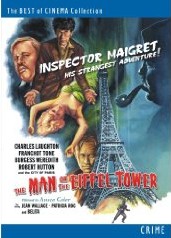- This essay will inevitably contain spoilers!
'THE MAN ON THE EIFFEL TOWER' (1949)

- A review by Richard Harrison (2010)
It is a peculiarity of the 21st Century movie star that they feel they
can diversify into other fields of artistry without, it seems, any
grasp that people aren’t always good at everything. Thus, it is not
uncommon now for actors to star in a few films, turn their hand to
directing and even make records. George Clooney, Kevin Costner, Ben
Affleck and Kiefer Sutherland are just four names who have made the
transition (or rather leap) to directing, Steven Seagal one name who
has branched out into music. Once this simply was not the case- actors
knew their place, and were humble enough to stick to doing what they
did best. Therefore, we can only surmise at what a Cary Grant directed
film would look like, or what the over-riding themes of Gary Cooper’s
films would be. Of course, as with most rules, there were exceptions.
Charles Laughton’s solitary venture behind the camera for Night of
the Hunter (1955) is now considered a triumph, though it was not
praised at the time. Burgess Meredith also took a brief turn behind the
camera (replacing Irving Allen, reputedly at Charles Laughton’s behest)
for The Man on the Eiffel Tower, an RKO curio from 1949.
Usually, a studio system film would not merit the “curio” tag, but The
Man
on
the
Eiffel Tower certainly does. Shot in ANSCO Colour (the
European equivalent of Technicolor), the film captures post-war Paris
in fascinating (if rather fragmentary) fashion. Indeed, the move out of
the studio backlot and onto the streets of Paris has an unusual effect,
and it is this, allied to the colour film stock, that gives The Man
on the Eiffel Tower a rather exotic aspect. (It is worth noting
that the importance of the city itself is recognised in the opening
credits- it is listed in a frame on its own along with the actors).
One of the other reasons the film is such an oddity is in its casting.
Inspector Maigret is played by the (miscast) Charles Laughton, who
strikes an uneasy balance between Henry VIII-style over-bearing-ness
and that of a bewildered bystander. Johann Radek is portrayed by
Franchot Tone (a mainstay of 1930s films but now, in his mid. 40s,
finding major film roles impossible to procure). The pair are ably
supported by Burgess Meredith (who should really have stayed in front
of the camera) and less ably by a range of other stars and starlets who
fight wooden dialogue and leaden direction with admirable- if futile-
spirit. Given this offbeat mix of cinematic ingredients, The Man on
the Eiffel Tower could have been something much, much better if it
were in the hands of an experienced director such as Hitchcock or
practically any of the émigrés who made such
atmospheric Noirs in the 1940s and 1950s.
Given its many shortcomings, should The Man on the Eiffel Tower
be valued? Surprisingly, my answer would be ‘yes’. Unlike many films
which have very little points of interest, this little film has
several- even if they are not particularly well executed. If nothing
else, the use of the (now faded) ANSCO colour process makes it a
necessary piece in the jigsaw in the technological development of
cinema, the rather bizarre performances combined with the unusual use
of location filming adding to the tapestry of a film which, thanks to
Odeon Entertainment, is freely available once again.
Odeon Entertainment website
Back
Home

